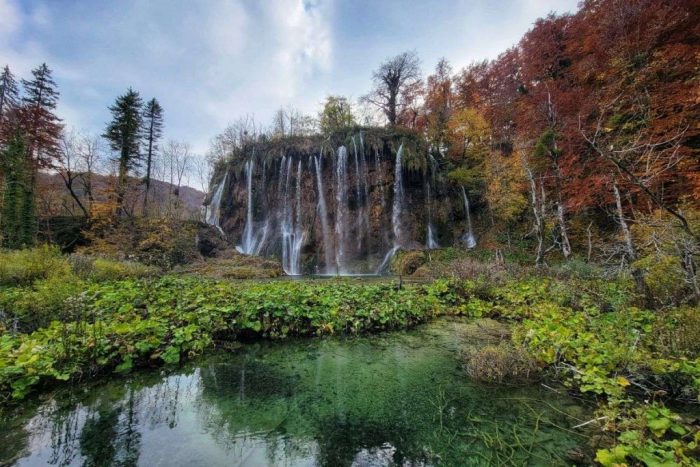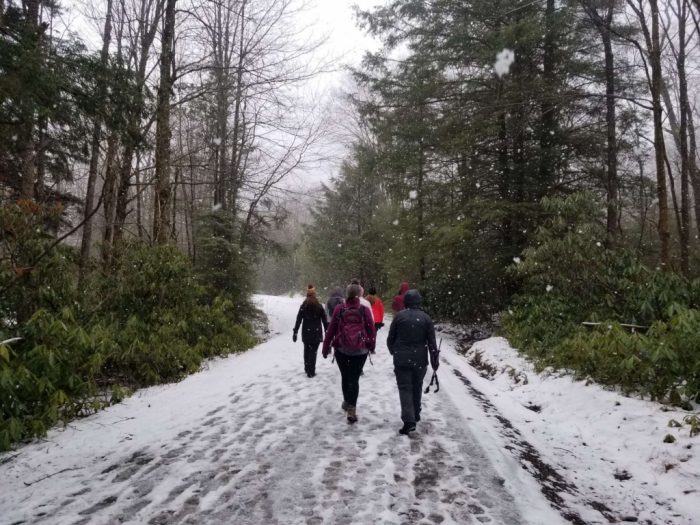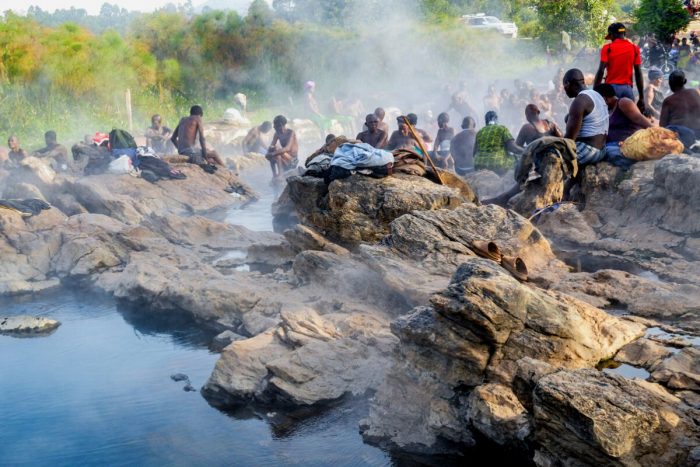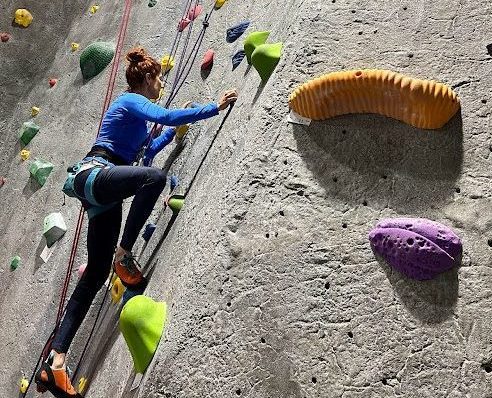Training to Hike the Grand Canyon: Gear, Tips, and Exercises
**This post supports our new Explorer Chick Fit program in collaboration with certified training professional, Ulrike Rosser.
Millions of people visit the Grand Canyon every year, but most stick to the rims or the easier trails near the top. No judgement — Grand Canyon National Park is incredible whether you’re standing on one rim or you trek into its depths, and hiking rim to rim or down and back up is not for everyone (cause it’s freaking hard!).
Carved out by the Colorado River over thousands of years, the immense gorge is a mile deep and stretches 18 miles across in some sections. Bands of red rock stripe the canyon walls from rim to floor, contrasting with the blues, greens, and browns of the water below. From the top, you can see for miles and every inch of the view is extraordinary.
However, below the rim? It’s a whole other story just waiting to be read. We’ll be the first to say this shit ain’t easy, but it’s absolutely worth it. Getting down to the Colorado river, you get a more intimate, full view of this insane canyon — and experience what it means to put your leg muscles through a minimum of 4,460 feet of climbing in 7.8 miles.
But to make it happen, even for experienced hikers, Britney Spears says it best: “you gotta work, bitch.” And that’s what we’re talking about in this post! In collaboration with our new EC Fit trainer, Ulrike Rosser, we’ve put together a list of training tips and physical training moves to get you ready to take on the Grand Canyon hike of your dreams.
What to Expect Hiking the Grand Canyon
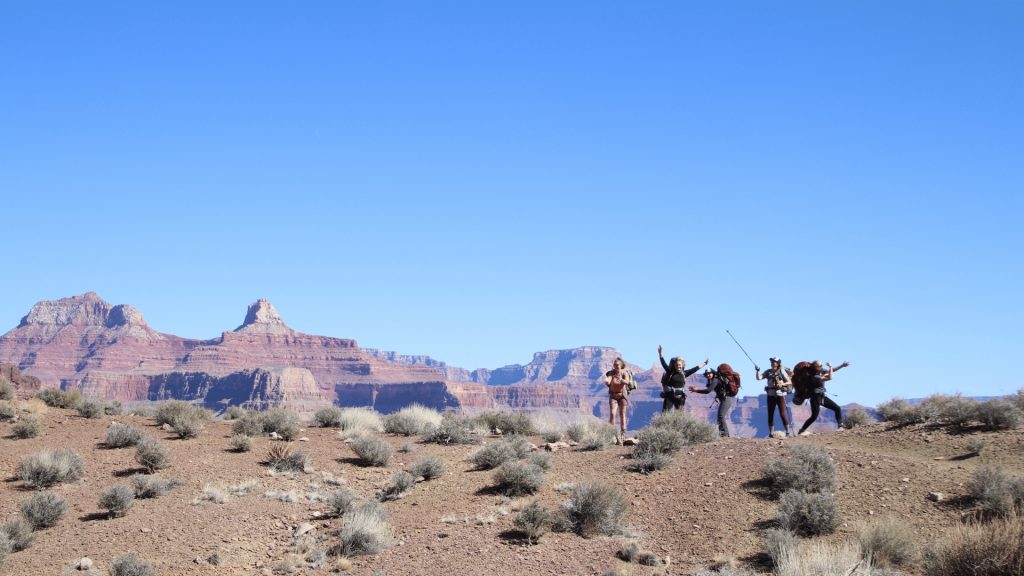
Hiking the Grand Canyon is an incredible experience, but it’s a challenge even for people who are otherwise in fairly good shape.
If you’re planning a rim to rim hike, descending into the canyon on one side and back up on the other, you can expect to cover at least 24 miles. For the out-and-back approach, following the Bright Angel, South Kaibab, or North Kaibab trails into and out of the canyon, the distance ranges from 15 to 28 miles.
No matter what route you take, you’re going to cover a lot of ground. But it’s not just the distance that makes hiking the Grand Canyon a physical feat you can brag about — it’s that, the elevation gain, and the the extreme weather changes the canyon often creates!
Here are some of the Grand Canyon conditions you can expect for your trip:
- High Elevation: A Grand Canyon hike always starts at one of the rims. The North Rim stands at 8,000 feet, while the South Rim’s elevation is 7,000. At those heights, the air is thin, making it harder to breathe–the last thing you want for a strenuous hike–and making altitude sickness a possibility.
- Dry Desert Air: Hiking through a desert canyon doesn’t just mean you’ll see a couple of cute cacti — you just might feel like one too. Humidity levels at the Grand Canyon frequently fall below 10%, causing sweat to evaporate before it can cool the skin, making it more difficult to regulate body temperature. Visitors also frequently underestimate their water needs, risking dehydration.
- Varying Climate: According to the National Park Service, for every 1,000 vertical feet you travel deeper into the canyon, you can expect the temperature to rise 5.5°F. From rim to floor, that’s a swing of nearly 30°–not even taking daily fluctuations into consideration. Nights at the Grand Canyon are typically cool, but summer daytime temperatures can frequently top 100°F inside the canyon.
- Exposure: A significant portion of Grand Canyon trails are exposed to the elements. Usually that’s sun, but it can include rain, particularly during the summer monsoon season.
- Steep Routes: If we haven’t made it clear yet, there is a significant drop in elevation from the top of the canyon to the bottom — in some places, more than 5,000 feet spread over less than 10 miles. All of the Grand Canyon’s trails are steep, with sharp switchbacks that zip back and forth across the canyon wall. The angle of the path can be hard on the body, especially the knees.
- Limited Access to Technology and Resources: You can’t call for an Uber on the canyon floor, and there are no vending machines along the trail. If you’ve historically relied on your cell phone for navigation, it’s time to get acquainted with old school technology–and bring your own snacks too.
With all these factors combined, we recommend training to hike the Grand Canyon before you go. We have more on that below, but first let’s go over the gear you’ll need.
Gear You Need to Hike the Grand Canyon
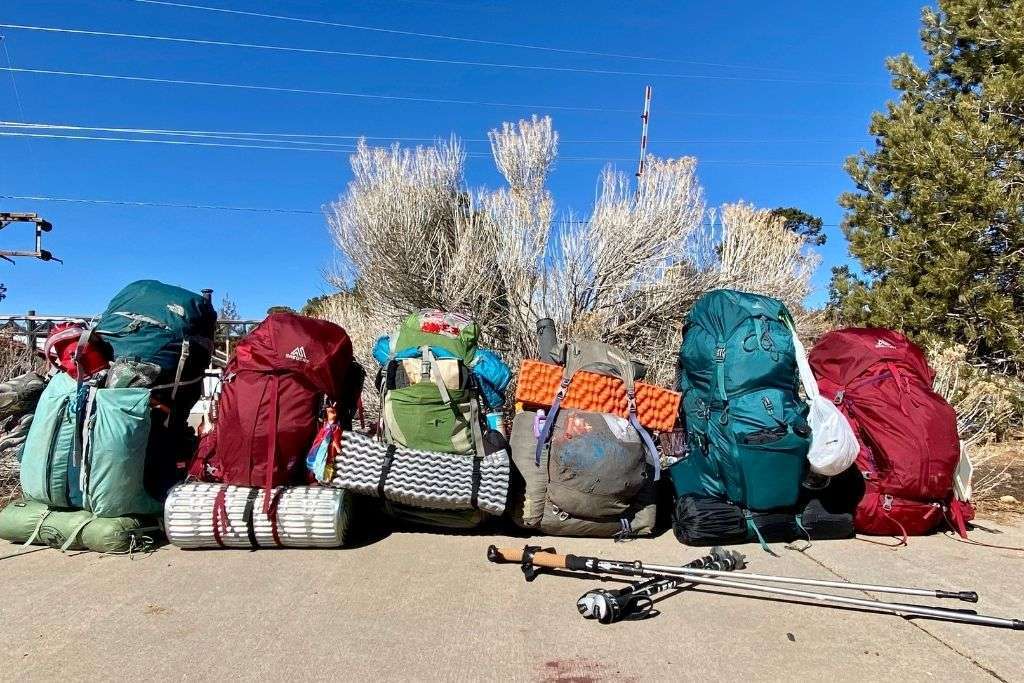
Whether you’re backpacking the Grand Canyon or you plan to complete your hike in a day, you should always be prepared. That means being ready for a sudden change in the weather, a slower-than-expected hike that requires you to make camp for the night, or even an injury.
Of course, this does mean that you’ll need to carry a full backpack throughout your hike, adding an extra–but essential–burden to the trek. Great gear can help to make that burden a little easier. Here’s our list of essential gear to help you choose and stuff that backpack well:
- A good backpack: Your backpack or daypack should have padded straps, a hip belt, and a chest strap to keep you as comfortable as possible as you haul your stuff through the canyon. We use the Osprey Ariel Plus 70 Women’s pack on our backpacking trips (see the full review here).
- Hiking boots or hiking shoes: Don’t skimp on the grip; you’ll want something with a deep tread that allows you to securely plant your feet with every step – especially when you’re descending into the canyon. See our full hiking boot guide here.
- Hiking poles: Whether you go for a single pole or a set, hiking poles can help to stabilize and ease the pressure on your legs, especially helpful when hiking steep trails.
- Extra clothing: With as much temperature variance as the Grand Canyon sees daily, dressing in layers is key, allowing you to add or remove warmth throughout the day. Pack a little extra insulation in case the weather suddenly changes.
- Extra food and water: Figure out how much food and water you think you need, then add more. You’ll never regret having too much, but we can’t say the same for having too little.
- Navigation tools: A map and a compass can save the day when you lose the trail, so make sure you pack (and know how to read) both.
- Sun Protection: Shield yourself from the sun and other elements with a hat, sunscreen, sunglasses, and SPF-blocking clothing if you have it.
- A first aid kit: Even a tiny blister can become a big problem on a 20-mile hike. Don’t leave home without a first aid kit and a working knowledge of how to use it.
- Illumination: With a flashlight or headlamp in your pack, you’ll never be caught in the dark.
- Camp Essentials: Whether you plan to camp in the canyon overnight or not, be ready for the possibility of camping with a shelter, a knife and/or other survival tools, and a way to start a fire.
(If you go on a Grand Canyon backpacking trip with Explorer Chick, we’ll send you a super detailed packing list and we provide all the backpacking and camping equipment like backpack, sleeping bag, sleeping pad, tent, trekking poles, and cookware.)
5 Tips on How to Train For Hiking the Grand Canyon (An Overview)
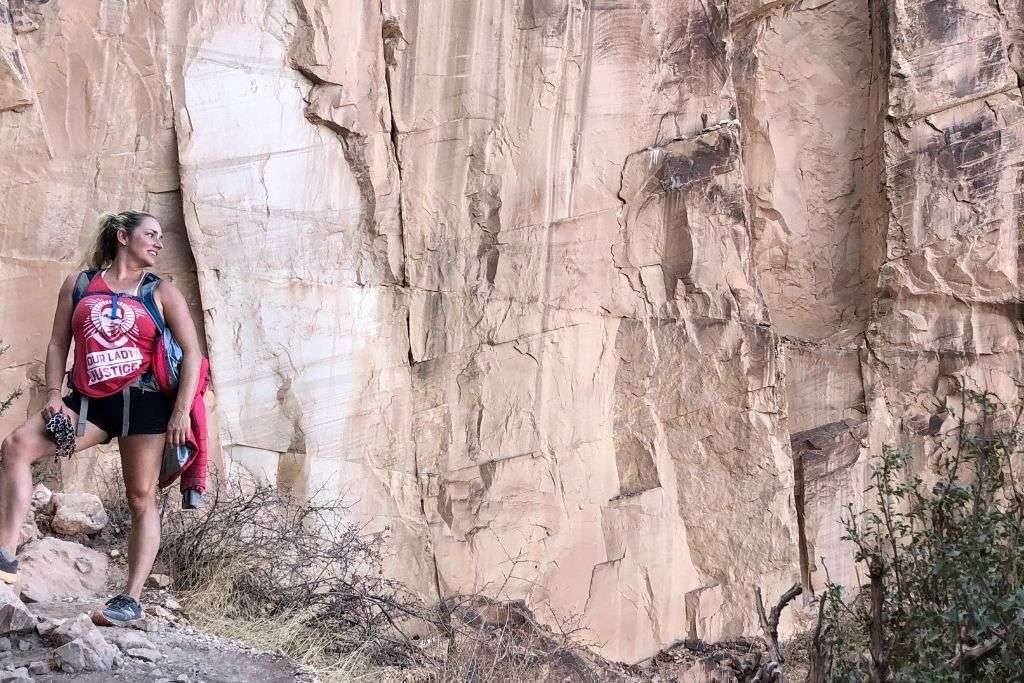
Explorer Chick’s Personal Trainer Ulrike Rosser hiked down the South Kaibab trail and up the Bright Angel trail in a day on a mother/daughter adventure nearly two years ago and loved every sweaty minute!
Here, she shares her tips for training for a Grand Canyon hike:
1. Train on the Trail – Any Trail
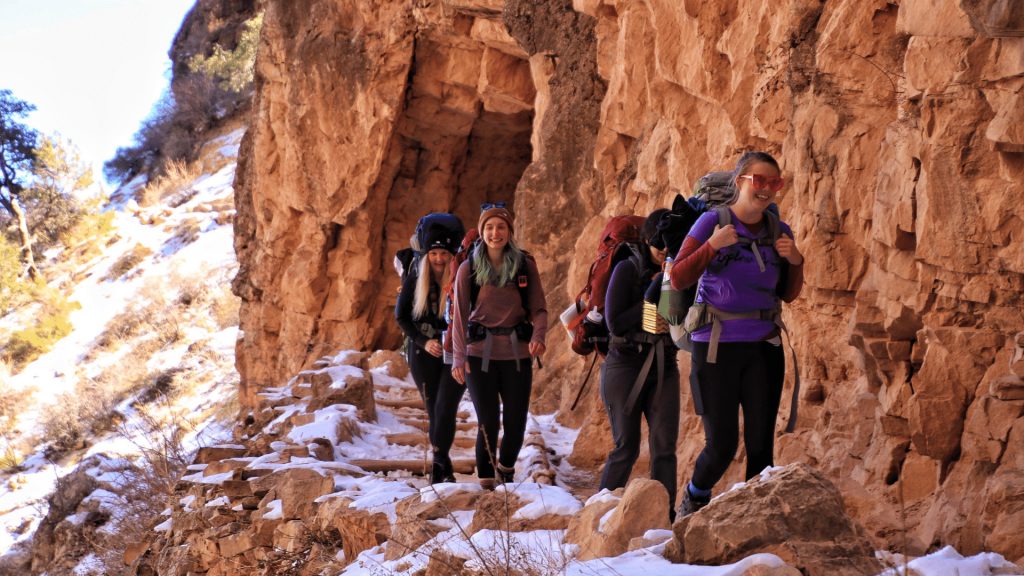
Ulrike says there’s nothing like getting out on the trail to train for a longer or more strenuous hike:
“Preparing for a long hike means, well, hiking! Before I attempted hiking up and down the Grand Canyon in one gorgeous day, I walked a lot to prepare! Time on the trail helps your body adapt to moving all day.”
No access or time to venture out to hiking trails? No problem.
“If weather or your schedule doesn’t permit getting out of town for a long hike, you can get in the distance by walking your local park or even your neighborhood,” Ulrike said.
2. Hill Climbs
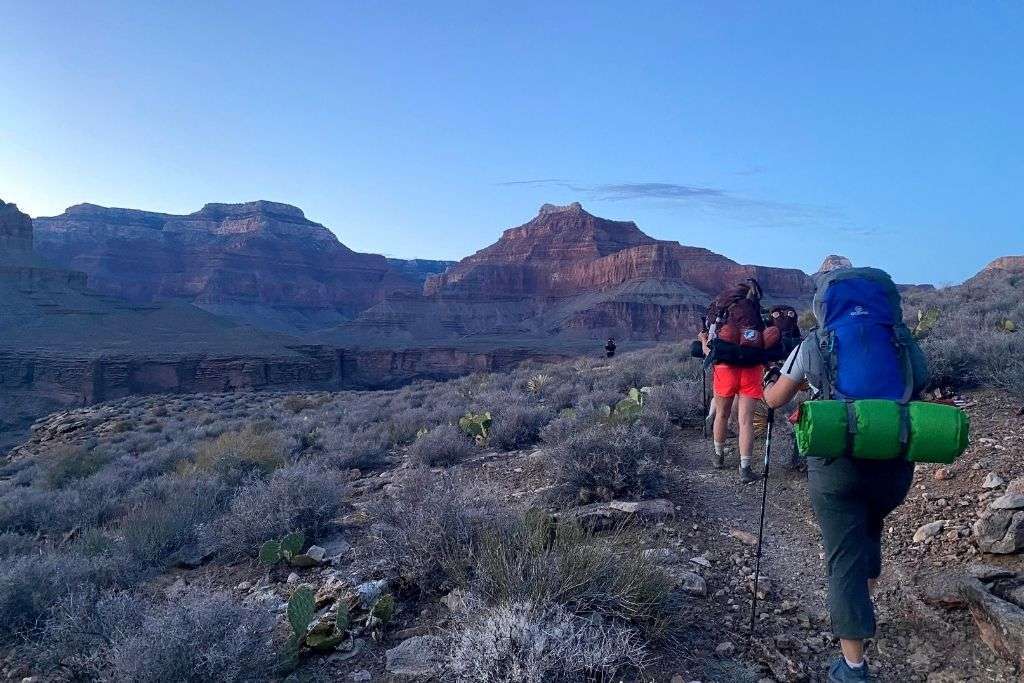
“Being prepared for an epic amount of switchbacks out one of the world’s biggest canyons requires legs capable of climbing,” says Ulrike. “I remember standing at the bottom of the Grand Canyon and I couldn’t even see the rim I was climbing towards! While there was nothing quite like seeing the Colorado River up close and personal, there was also nothing quite like the final two miles of climbing out of the Grand Canyon.”
Training for the climb is essential to preparing for a Grand Canyon hike.
“The best way to do this is find a hill, and climb it,” she explains. “And then once you’re done with that, climb it again! Doing this 5-10 times can mimic the pressures of a whole lot of uphill.”
3. Work on Cardio
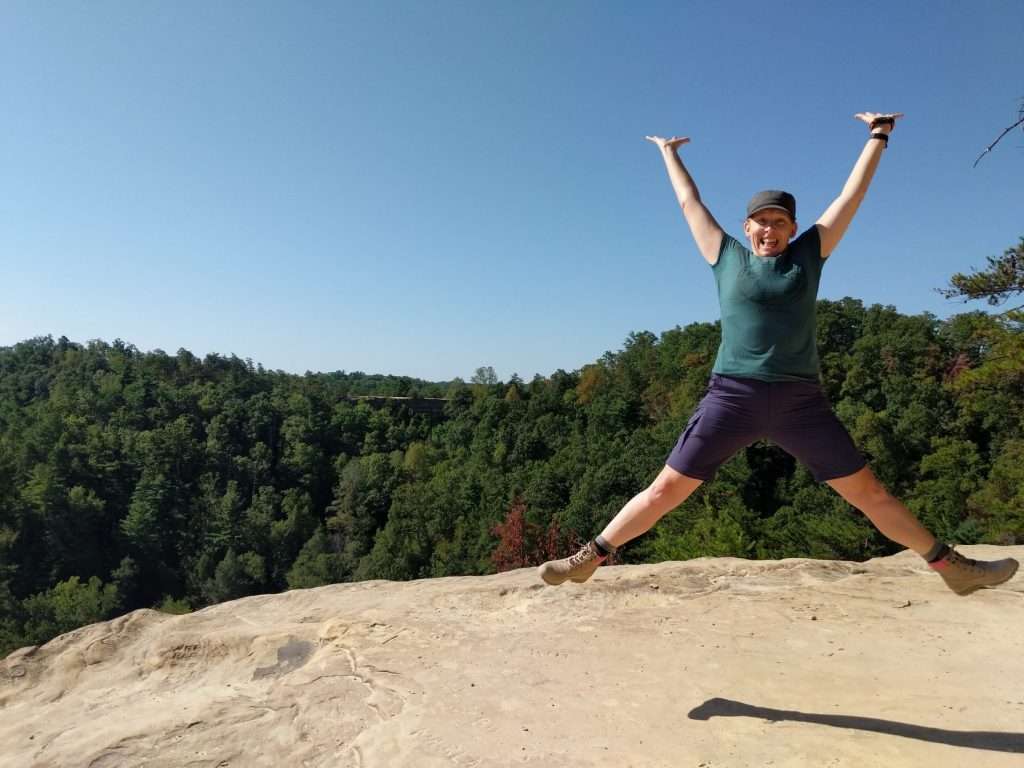
“Did I mention the uphills?” says Ulrike.
I think we’ve mentioned it a few times by now, but hiking the Grand Canyon requires a lot (and then some) of time going uphill and down.
“Hiking that much uphill requires a strong cardiovascular system.” Ulrike says. “There’s lots of ways to add cardio training in before taking on the Grand Canyon. Hiking is one example, but you can also add gym classes, a bike ride, jumping rope, or even jumping jacks in the living room.”
4. Build Endurance
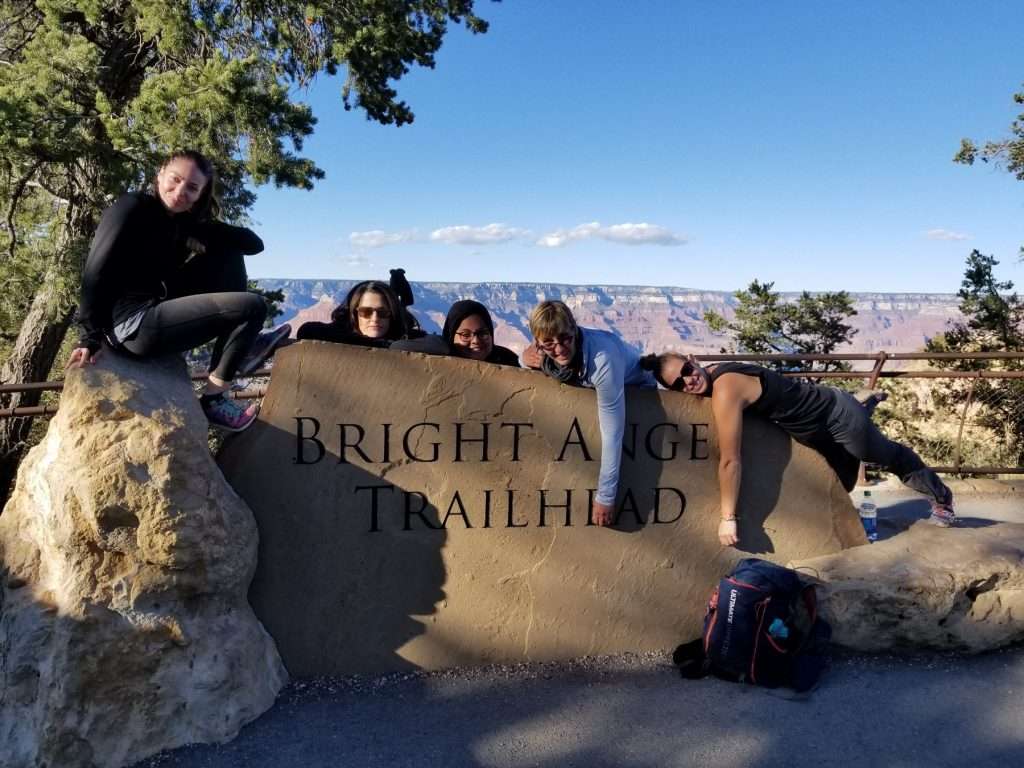
When you’re planning to cover 15-30 miles of distance — especially if you want to tackle it in a day — you’re going to need more than just a burst of energy. Here’s how Ulrike trained, and a few options she recommends:
“I knew hiking the Canyon would be a long, full day, so just working on cardio wasn’t an option — I also needed endurance! Cardio training might get your heart and lungs capable, but endurance training refers to building up your ability to “endure” on the trail. This means a combo of muscular training and cardiovascular ability.
HIIT [High-Intensity Interval Training] workout classes are great for both cardio and endurance. Adding one in weekly can increase your endurance significantly in less time. You can also add in brisk walking or those sweet hikes you’ve been meaning to try. Try to increase in volume and stamina every time you add this in.”
5. Get Comfortable With Your Gear
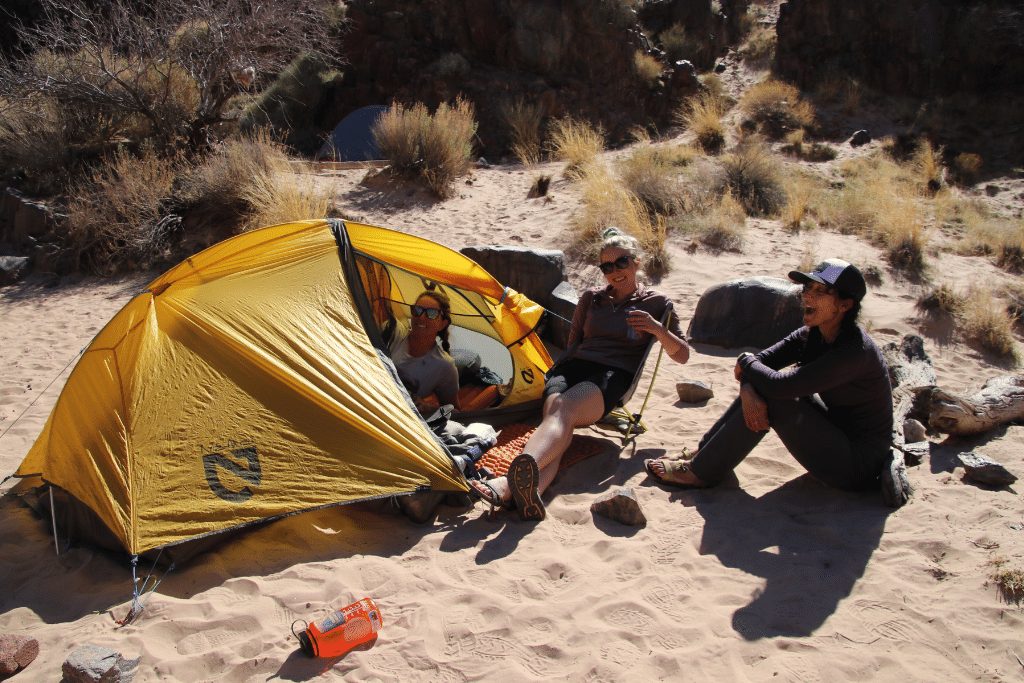
Our last tip is an important one for any outdoor adventure: always make sure you know how to use your gear before you hit the trail. Whether your stuff is brand new or you’ve owned it for years, pull it out well before the hike and practice using it. Part of training to hike the Grand Canyon is knowing you can handle your gear quickly and successfully in an emergency.
It’s also a good idea to pack everything into your backpack and do a dry run with the weight you expect to carry. If you’re uncomfortable from the start, make adjustments: find ways to lighten the load (without losing any of the essentials) or adjust your pack, playing with the straps and the way you load it.
Recommended Training Regimen For Your Grand Canyon Hike
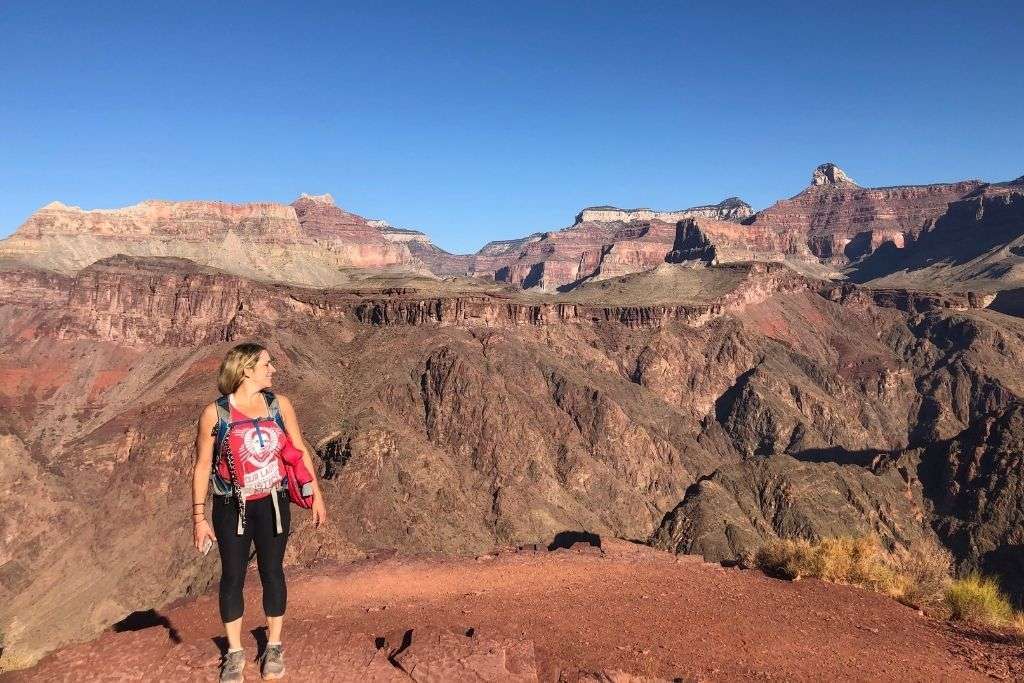
By now you might be wondering exactly how to train for hiking the Grand Canyon. Never fear: Ulrike has us covered. She’s recommended four moves you can add to your training to help you crush that hike like the rockstar you are!
Looking for different training moves? Check out our training guide for hiking Yosemite’s Half Dome, moves to get into general hiking shape, or join us for our new 8-week Explorer Chick Fit program for structured training and our signature Explorer Chick community! (EC Fit goes live on Monday, so sign up for our newsletter to get notified!)
Complete these four exercises 2-3 times a week, along with a weekly hike, and you’ll be ready for the Grand Canyon in no time!
1. Best for Knee Pain: Step Ups and Step Downs
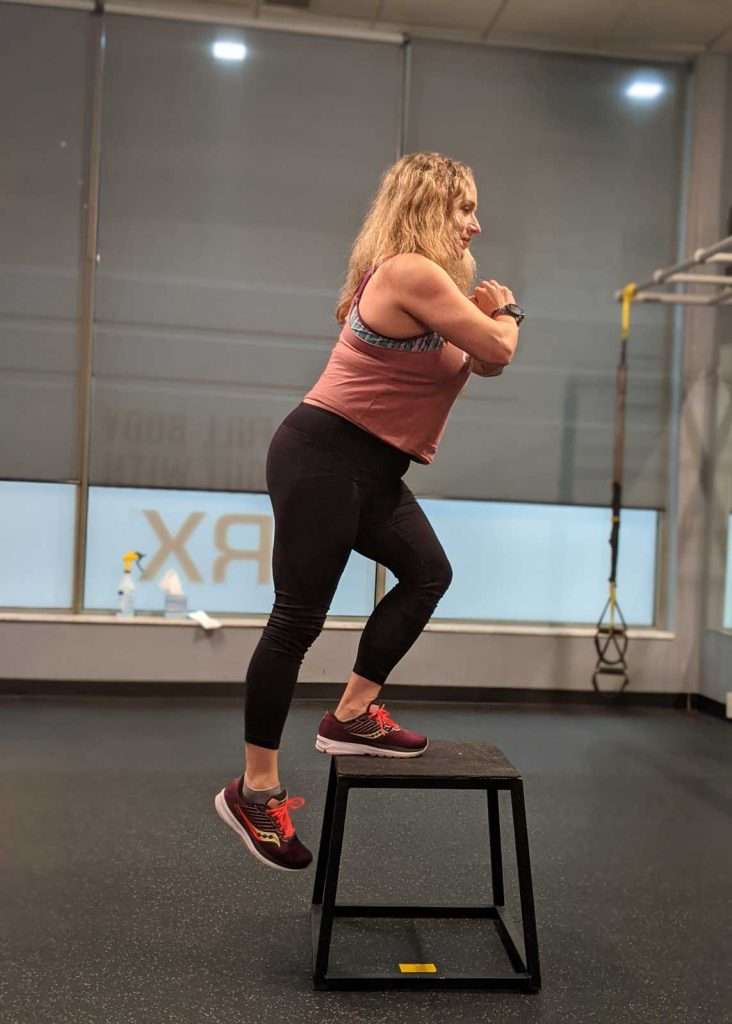
Doing step ups on a park bench or your gym’s box will safely train your legs and core how to climb! You’ll start by keeping your chest as open as possible (try looking ahead, instead of directly at your own feet to help) and step your foot firmly onto an elevated surface. Follow with your second leg and make sure to fully extend your body at the top.
However, while step ups are great for learning how to climb, a lot of the Grand Canyon is downhill, so that’s where we can switch this step up to step downs. This time, you’ll start on top of the elevated surface of your choice. Look forward as you lower one leg very closely towards the ground and still keep your shoulders from curving towards your legs. You should feel your glutes turning on to protect those knees!
Aim for 1 minute of step ups, 1 minute of step downs, then a one minute break, for 9 to 15 minutes for big burn and big results.
Pro-Tip: You can add a dumbbell to your shoulder on the step-ups to add extra burn, switching sides at mid-way or each time, but don’t add it to your step-downs — your glutes already have lots to do.
2. Best for Elevation Gain: Walking Lunges
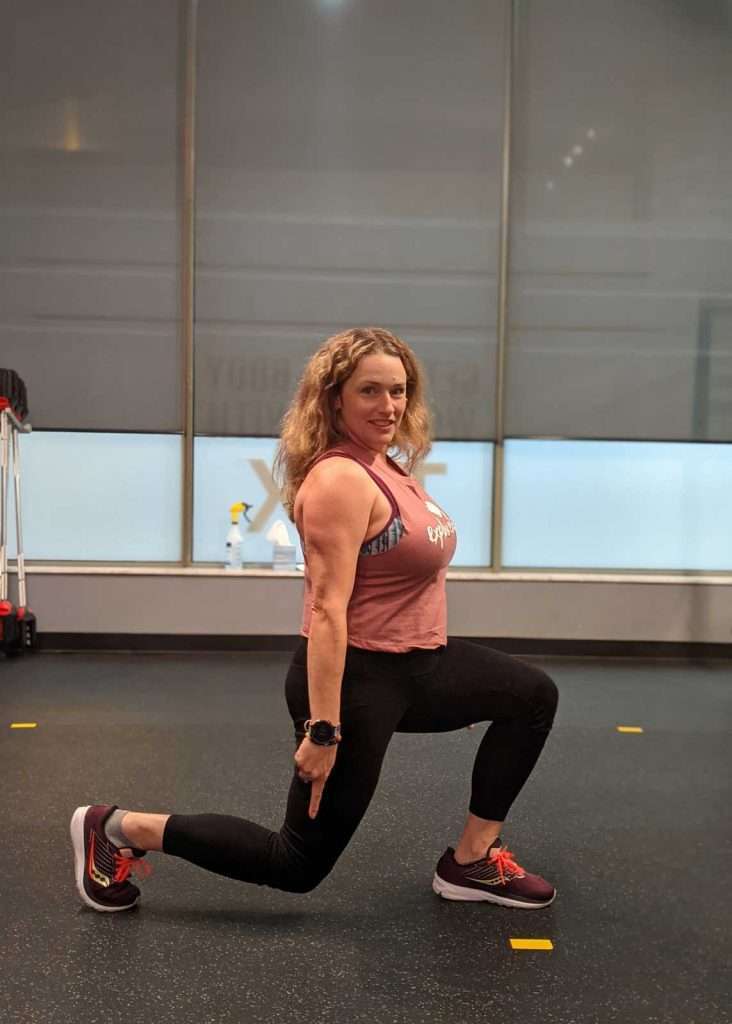
Lunging is that pesky exercise that magically makes you better at climbing things! Carve out some space at the park, or a parking lot to lunge forward. Keep your chest level, make sure your ribcage is securely over your hips, and check that your shoulders aren’t sloping forward.
Then step one foot forward, aiming for a long stance where your front knee is now over your ankle and your back knee heads towards the ground (but doesn’t touch, in a parking lot that’s ouch!). Then, you know, keep going! Lunge the length of a few parking spots or aim for 10 lunges total, and then turnaround and lunge back the direction you came!
10 rounds of this will have you feeling prepared for the final two miles of climbing out of the canyon and trust me, you will want to feel prepared for those miles.
Pro-tip: Watch out for knee and ankle pain by making sure your lunges are long enough! Your body might feel like shortening the stance will somehow make these easier, but instead it can cause ankle instability or knee pain. Open heart and long legs will help you get the most out of this exercise!
3. Best For Everyone: Goblet Squat or Prisoner Arm Squat
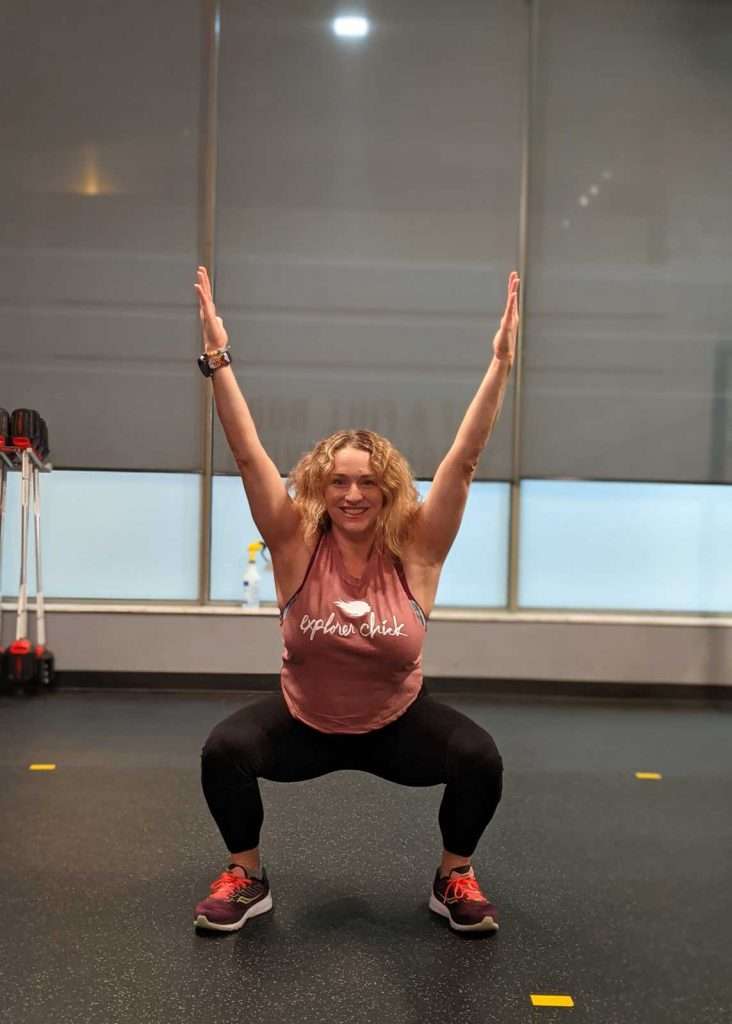
Between packing it all in and out, the gravity, the climbs, and standing strong to enjoy all those amazing views, you need to be prepared for everything. Before getting to the real thing, get full body stability by adding in squats — specifically goblet squats or prisoner arm squats.
Start your squat with feet slightly wider than hip distance, and think of rooting your mid-foot to the ground. I like to pretend I’m growing an actual long root from my mid-foot into the earth! When you squat, drop down to parallel with your hips and then power back up to standing.
If you have access to a dumbbell or kettlebell, feel free to turn this into a goblet squat. Pick a weight that feels heavy but doesn’t cause your back pain. Squeeze the base of the dumbbell or hold the horns of the kettlebell between your hands and make sure not to let the weight pull your chest forward.
We’re adding weight to help create more upper body stability, but if you don’t want to add weight or don’t have access, you can still build lots of upper body stability by adding a prisoner arm stance to your squat. Lift your arms and put your fingertips behind your head, making sure to keep your elbows open wide.
Add 15-20 squats to each workout!
Pro-tip: If you have pain in your knees, check your stance! You might not have those feet wide enough and it’s causing pain. Make sure you have enough room for your hiker booty to fit between those legs!
4. Best For Carrying Your Pack: Plank Holds
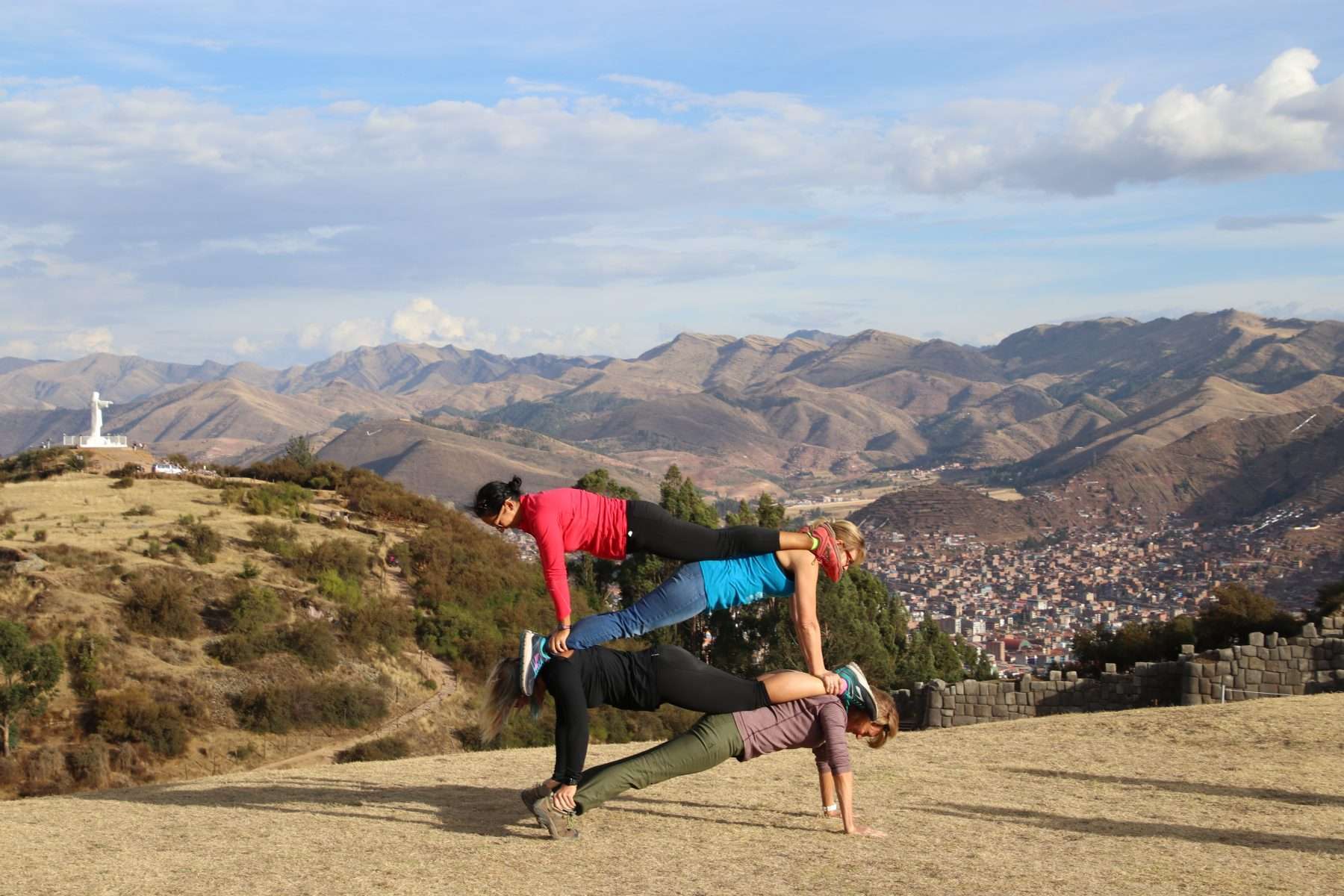
It’s hard to believe, but your legs might not be the most sore part of you at the end of this adventure! Climbing in (and then out) of the world’s biggest canyon means packing in and out your own water, snacks, and even wardrobe for when it’s cold starting and really hot in the middle! Carrying a pack while adjusting to a lot of force pushing you and that pack forward while you hike down and the same force pushing you backwards while you hike up means some serious work on your mid-back.
Adding plank holds to your workouts before climbing the Grand Canyon will help you build stronger ab muscles and a stronger back, so you can carry everything you need without fear of pain.
To set up your plank, take it to the floor and roll those shoulders away from your ears, engaging your shoulders down your back. Don’t forget that your hands have muscles too, that can really help support a strong plank! Think about putting your index finger forward and engaging those fingers and finger pads into the floor.
Once your arms and shoulders are ready to rock, check in with the rest of your body. You can do this move in a full plank or make it easier by having your knees on the ground. If you have your knees down, make sure your body’s in one straight line from knees to neck. If you’re doing a full plank, lift those knees and press out through your heels, creating a long and strong plank!
Hold your plank for at least 20 seconds, building up to 40 seconds to a minute, and add in one to three rounds each time you workout. If you’d like more resistance, try putting your feet into some TRX straps to suspend your plank away from the floor.
Pro-tip: If you struggle with low back pain doing a plank, grab a yoga block or a mini exercise ball and tuck it between your inner thighs, close to your hips. Squeeze the ball with your inner thighs as you plank — it turns on those abs which will help mitigate back pain!
Come Backpacking in the Grand Canyon With Explorer Chick!
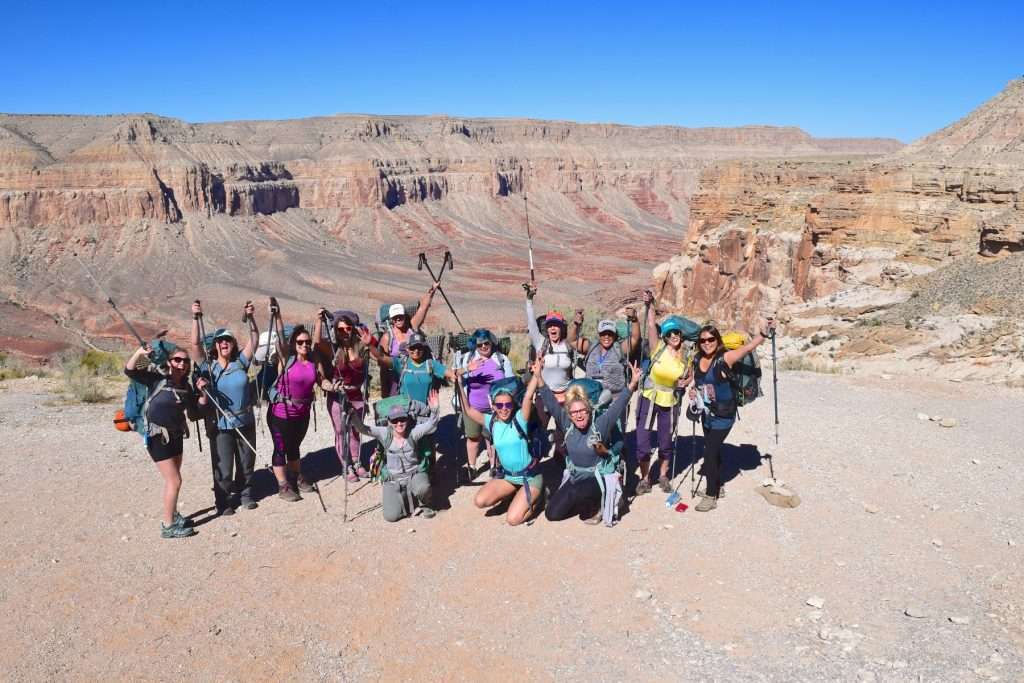
It doesn’t matter whether you’re ready to hike the Grand Canyon tomorrow or in six months–after thousands of years, the canyon certainly isn’t going anywhere, and neither is Explorer Chick. Activate your inner beast mode with our Grand Canyon backpacking trip. You’ll spend four days and three nights in the canyon, trekking your heart out, sleeping under the stars, and making new hiker BFFs.
Meet the Writer

Ulrike Rosser
Ulrike is an avid hiker, mountain biker, and outdoors enthusiast. In her free time, she trains personal clients and group fitness classes to the end goal of being fit enough to truly enjoy and appreciate a full, adventurous life.
Ulrike is TRX certified, Kettlebell certified, a NASM Certified Personal Trainer and Group Fitness Instructor, and a 200hr Registered Yoga Teacher through the Yoga Alliance. More importantly, she’s also certified by a few decades of life, which means she knows the pursuit for a perfect body (like what is that anyway???) is nowhere as important as a badass body that can climb mountains, throw on a pack (or pick up a kid), and meet all of life’s challenges with strength and capacity.
Read More Training Tips
- Training to Hike the Grand Canyon: Gear, Tips, and Exercises
- Knee Pain Hiking Downhill: Causes, Prevention, and Exercises
- Angels Landing: The Scariest Hike You’ll Never Forget
- How to Train for Hiking: 5 Moves to Get You into Hiking Shape
- Training for Half Dome and Half Dome Cables
- How to Choose the Best Hiking Boots for Women
- How to Start Backpacking: 6 Things You MUST Know
- How to Train for Hiking and Backpacking Trips


